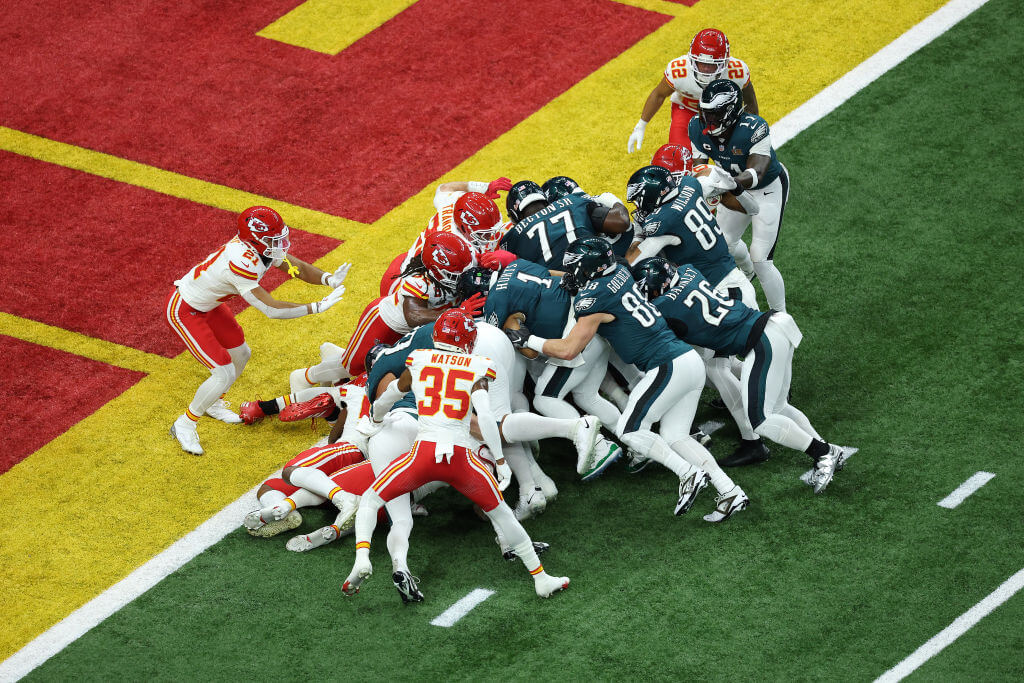How Yiddish inspired the Philadelphia Eagles’ winning play in Super Bowl 2025
The Jewish legacy of the ‘tush push’

Jalen Hurts of the Philadelphia Eagles scores a touchdown using the “tush push” play in the first quarter against the Kansas City Chiefs during Super Bowl LIX in New Orleans. Photo by Patrick Smith/Getty Images
The Philadelphia Eagles didn’t just beat the Kansas City Chiefs in Super Bowl 2025, 40-22, they scored their first touchdown using the “tush push,” a play as straightforward as football gets: when the Eagles need a yard — whether on third-and-short, fourth-and-inches, or at the goal line — quarterback Jalen Hurts crouches and a human avalanche of teammates shoves him forward. There is no finesse, no deception, no nuance — just momentum, mass and an unshakable belief that physics will do the rest.
What started as a quirk of strategy has become the most debated play in football. Critics call it ugly and say it should be banned. Defenders call it unstoppable. The Eagles just call it first down. The play itself is a modern update, and its name carries a legacy as well that stretches back much further — to Yiddish, to Jewish comedy and to one of the most gloriously ridiculous musical numbers in cinema.
The Yiddish origins of ‘tush’
It’s hard to imagine the NFL’s most polarizing play being named after a bubbe’s favorite word for your rear end, but here we are.
The word “tush” has the rare distinction of being both delightfully childish and deeply rooted in linguistic history. It comes from the Yiddish “tukhes,” which itself traces back to the Hebrew “tachat,” meaning “bottom” or “rear” — essentially, the thing getting shoved forward by Philadelphia about 20 times a game.
But why “tush” instead of “tukhes”? That has its own backstory.
YIVO, a leading authority on the Yiddish language, spells the word “tukhes” instead of “tuchus” because Americans would often mispronounce it with a soft “ch,” as in child, so it sounded like tu-CH-is. That type of mispronunciation is why the Forward’s Yiddish editor, Rukhl Schaechter, spells her first name the way she does. “Otherwise,” she told me, “people would pronounce my name Ru-CH-l,” as if it rhymes with “cudgel.”
Over time, as Yiddish wove its way into American slang — thanks to the likes of comedians, deli counters and doting grandmothers — “tukhes” became “tush,” and “tush” became a word so universally accepted that it could headline a football strategy without anyone batting an eye or recognizing its origins.
Look up tush in the Merriam-Webster Dictionary and you’ll find a bunch of synonyms: bootie, keester, rump — but none, crucially, rhyme with “push.”
Yiddish in the end zone
The football version of the tush push dates back to at least the 2017-2018 season, when the Indianapolis Colts used it. Nick Sirianni, formerly the offensive coordinator for the Colts, brought it with him to Philadelphia when he became head coach in 2021.
By 2022, the team had perfected the play so that it worked 25 out of 27 times — an absurdly high success rate. That was thanks in large part to their powerhouse center, Jason Kelce (whose brother, Travis of the Kansas City Chiefs, is playing in this year’s Super Bowl, though he is perhaps better known among some for dating Taylor Swift). Other teams, at both the professional and collegiate levels, started copying the move, but no one has mastered it quite like Philadelphia.
Since the play is so strongly associated with the Eagles, it has also been dubbed, less Jewishly, the “Brotherly Shove” — a nod to Philadelphia’s “City of Brotherly Love” nickname. But football purists insist it’s just an advanced version of the quarterback sneak, a play that’s been around since leather helmets were a thing.
At this point, the play has become so dominant that the NFL felt compelled to call in an actual astrophysicist. Enter Neil deGrasse Tyson, who broke down the tush push using Newton’s Laws of Motion.
Physics 🤝 Football@neiltyson breaks down the Tush Push with @KyleBrandt pic.twitter.com/VC7diDLZus
— NFL GameDay (@NFLGameDay) January 14, 2024
Mel Brooks introduced a ‘tush push dance’
If you thought the tush push was a uniquely Philadelphia invention, Mel Brooks might have something to say about that. Long before the Eagles were barreling forward on fourth-and-one, Brooks had a variation in Blazing Saddles.
The setup: The 1974 film’s climactic bar fight between cowboys spills over into an adjacent Hollywood soundstage, where an over-the-top Broadway-style musical number is underway. The camera zooms in on a line of top-hatted chorus boys, merrily kicking their way through a routine while singing a refrain that sounds eerily like instructions for the Philadelphia Eagles’ offensive line:
Throw out your hands!
Stick out your tush!
Hands on your hips!
Give ‘em a push!
Then, because this is Mel Brooks, the entire thing collapses into a full-fledged riot between cowboys and tuxedoed dancers.
In the last few decades, the “tush push” has become a popular country line dance.
Football and Yiddish may seem like strange bedfellows, but Schaechter isn’t surprised that a Yiddishism made its way into the NFL lexicon. “We don’t have that many words from Italian or from French,” she said. “We’ve had so many immigrants coming to America, and of all of them, somehow it’s the Yiddish that has infiltrated English so much more.”
And on Super Bowl Sunday, the entire world watched a team win a championship by running a play named after a Yiddish word for butt.
Somewhere, Mel Brooks is probably kvelling.
















